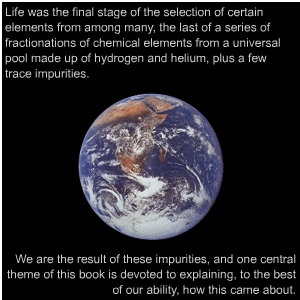|
Our Earth has an atmosphere today only because of outgassing of
the planetary interior, mainly through volcanic action after surface
temperatures had fallen. The gases that were emitted were not those
that were most common in the original material of the solar system,
but those that could be trapped in chemical combination with minerals:
water vapor, ammonia, hydrogen sulfide, carbon dioxide, and other
small carbon and nitrogen molecules. The helium that was present
initially was lost because it did not react chemically and could
not be retained in a nonvolatile form.
Our present atmosphere, which essentially is 80% nitrogen and
20% oxygen, is quite different even from the original outgassed
atmosphere. That primal atmosphere contained many components that
would combine readily with oxygen, but did not contain free oxygen
itself. Today's oxygen-rich atmosphere is the result of the slow
action by one of the most remarkable phenomena to arise in the
universe: Life. Out of this pool of carbon, oxygen, nitrogen,
and hydrogen compounds, on the surface of a ball of silicate rock,
there evolved the most complex and most subtle chemical systems
that the universe has known: living organisms.
The story of how living organisms evolved and how they have transformed
our planet is a fascinating one, but one that will have to wait
until we have laid a chemical basis for understanding it. In the
last chapters of this book we will return to this subject, as
an attempt to tie everything together.
|
 |
